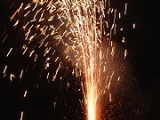
Roman candle
Encyclopedia
Roman candle is a traditional type of firework, that ejects one or more stars
or exploding shells.
Roman candles come in a variety of sizes, from small 6 mm (1/4") diameter for consumers, and up to 8 cm (3") diameter in professional fireworks displays.
Roman candles are banned in some countries due to their tendency to cause accidents.
, lifting charge, pyrotechnic star
, black powder, and delay charge. The device is ignited from the top. The delay powder is packed tightly in the tube, so that the flame cannot reach around the sides of the plug of delay composition. It therefore burns slowly; as it is consumed, the flame moves down through the tube. When the flame reaches the topmost pyrotechnic star, the star is ignited. Because the star fits loosely in the tube, the fire spreads around it and ignites the lift charge. The lift charge burns quickly, propelling the star out of the tube, like a bullet from a gun. In doing so it also ignites the layer of delay powder beneath it, and the process repeats.
There are several variations on this:
Pyrotechnic star
Pyrotechnic stars are pellets or simply pieces of pyrotechnic composition which may contain metal powders, salts or other compounds that, when ignited, burn a certain colour or exude a spark effect. They are a part of all projectile-type fireworks. The most common is the aerial shell. When...
or exploding shells.
Roman candles come in a variety of sizes, from small 6 mm (1/4") diameter for consumers, and up to 8 cm (3") diameter in professional fireworks displays.
Roman candles are banned in some countries due to their tendency to cause accidents.
Construction and ignition
A Roman candle is a firework constructed with bentoniteBentonite
Bentonite is an absorbent aluminium phyllosilicate, essentially impure clay consisting mostly of montmorillonite. There are different types of bentonite, each named after the respective dominant element, such as potassium , sodium , calcium , and aluminum . Experts debate a number of nomenclatorial...
, lifting charge, pyrotechnic star
Pyrotechnic star
Pyrotechnic stars are pellets or simply pieces of pyrotechnic composition which may contain metal powders, salts or other compounds that, when ignited, burn a certain colour or exude a spark effect. They are a part of all projectile-type fireworks. The most common is the aerial shell. When...
, black powder, and delay charge. The device is ignited from the top. The delay powder is packed tightly in the tube, so that the flame cannot reach around the sides of the plug of delay composition. It therefore burns slowly; as it is consumed, the flame moves down through the tube. When the flame reaches the topmost pyrotechnic star, the star is ignited. Because the star fits loosely in the tube, the fire spreads around it and ignites the lift charge. The lift charge burns quickly, propelling the star out of the tube, like a bullet from a gun. In doing so it also ignites the layer of delay powder beneath it, and the process repeats.
There are several variations on this:
- Many Chinese Roman candles use clayClayClay is a general term including many combinations of one or more clay minerals with traces of metal oxides and organic matter. Geologic clay deposits are mostly composed of phyllosilicate minerals containing variable amounts of water trapped in the mineral structure.- Formation :Clay minerals...
instead of delay powder and run a length of fuseFuse (explosives)In an explosive, pyrotechnic device or military munition, a fuse is the part of the device that initiates function. In common usage, the word fuse is used indiscriminately...
down the inside of the candle to time the lifts. - Larger Roman candles (3") will usually add more lift to the highest layers and less to the lower layers in order to cause the stars to lift to the same altitude. This is due to the shorter length of tube available for accelerating the higher stars (see firearms internal ballistics).
- Some very large candles will load comet shellComet (pyrotechnics)In pyrotechnics a comet is a block attached to the outside of a shell or launched freely, which burns and emits sparks as the shell is rising, leaving a trail in the sky. Some comets use a matrix composition with small stars embedded in it. The matrix composition burns with little light but...
s instead of stars.

